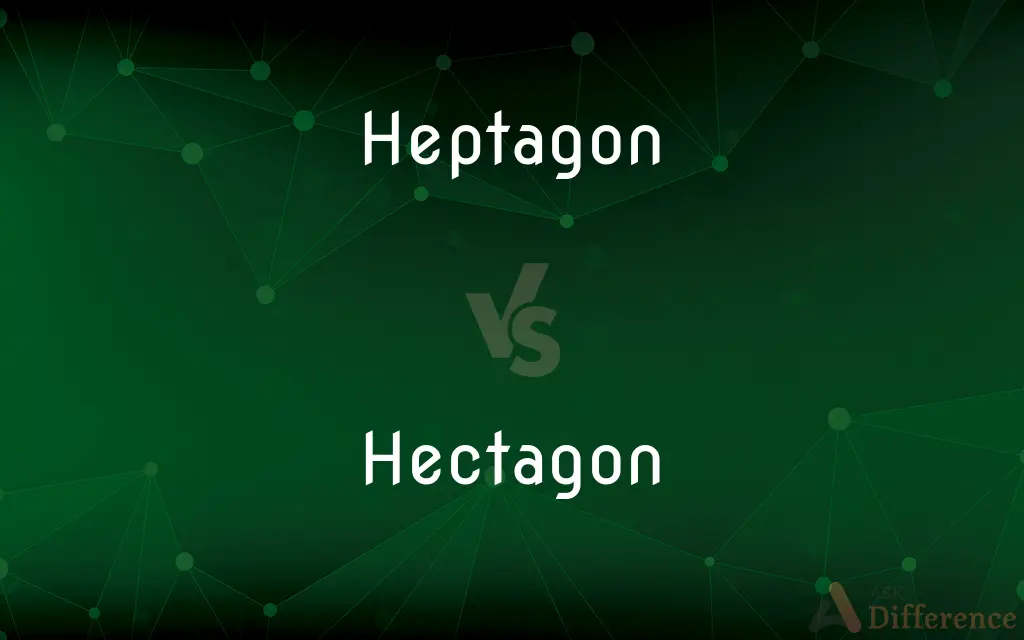Heptagon vs. Hectagon — What's the Difference?
By Tayyaba Rehman — Updated on November 5, 2023
A heptagon is a seven-sided polygon, while a hectagon, often confused with a hectogon, which is not a standard geometric term, could be misconstrued as a one-hundred-sided polygon.

Difference Between Heptagon and Hectagon
Table of Contents
ADVERTISEMENT
Key Differences
A heptagon is a polygon with seven sides and seven angles. Each internal angle in a regular heptagon - one where all sides and angles are equal - measures approximately 128.57 degrees. In contrast, the term "hectagon" is not widely recognized in geometry and seems to be a misinterpretation or a misspelling of "hectogon," which is occasionally used to refer to a 100-sided polygon, more commonly known as a hectogon.
Heptagons can be regular or irregular. A regular heptagon has sides of equal length and equal angles between each side, whereas an irregular heptagon does not have uniform sides or angles. A hectogon (if one interprets "hectagon" as such) would have 100 sides and, if regular, each internal angle would measure 176.4 degrees, indicative of its much larger number of sides compared to the heptagon.
In terms of symmetry, a regular heptagon has seven lines of symmetry, one for each side. The hectogon, being a polygon with 100 sides, would have 100 lines of symmetry if it is regular. The complexity of constructing a heptagon with straightedge and compass is not nearly as great as that of a hectogon, which is significantly more complex and not commonly constructed or utilized in practical applications.
The heptagon is often seen in everyday objects such as tables or decorations. There is rarely any mention of a "hectagon" in daily usage; this could lead to confusion with a hectogon, which due to its large number of sides is more a mathematical curiosity than a shape used in design or architecture.
Finally, when considering the etymology, “hepta” is a Greek root meaning 'seven,' aligning with the heptagon's seven sides. On the other hand, "hecta" or "hecto" signifies 'hundred,' which would imply that a "hectagon" intends to reference a shape with a hundred sides.
ADVERTISEMENT
Comparison Chart
Number of Sides
Seven
One hundred (in the case of a hectogon)
Angle Measures
~128.57 degrees (if regular)
176.4 degrees (if regular hectogon)
Lines of Symmetry
Seven (if regular)
One hundred (if regular hectogon)
Common Usage
More common in everyday life
Rarely used; mostly in mathematical context
Etymology
Greek 'hepta' for seven
Greek 'hecto' for hundred
Compare with Definitions
Heptagon
Heptagon shapes have seven angles.
Each angle of a regular heptagon measures approximately 128.57 degrees.
Hectagon
Hectogon shapes are mainly theoretical and not commonly seen in practical use.
The architect's design incorporated a hectogon, which was a topic of interest for mathematicians.
Heptagon
A regular heptagon features seven lines of symmetry.
The children's puzzle was shaped like a perfect heptagon, with all sides equal.
Hectagon
Hectogon, often miswritten as 'hectagon', is a complex polygon for construction.
The complexity of constructing a hectogon intrigued the math students.
Heptagon
Heptagons can be regular or irregular in geometry.
She drew an irregular heptagon, with none of its sides matching in length.
Hectagon
A hectogon is a polygon with one hundred sides.
In geometry class, we learned that a regular hectogon is practically impossible to draw by hand.
Heptagon
A heptagon is a polygon with seven sides.
The stop sign was mistakenly designed as a heptagon instead of an octagon.
Hectagon
A regular hectogon has internal angles of 176.4 degrees each.
The artist's abstract painting featured a pattern that resembled a hectogon.
Heptagon
In geometry, a heptagon is a seven-sided polygon or 7-gon. The heptagon is sometimes referred to as the septagon, using "sept-" (an elision of septua-, a Latin-derived numerical prefix, rather than hepta-, a Greek-derived numerical prefix; both are cognate) together with the Greek suffix "-agon" meaning angle.
Hectagon
The term hectogon comes from the Greek word for 'hundred'.
A hectogon is named after the Greek root 'hecto' indicating its hundred sides.
Heptagon
A plane figure with seven straight sides and angles.
Hectagon
A polygon with 100 edges, vertices, and angles.
Heptagon
A polygon with seven sides and seven angles.
Hectagon
Misspelling of hexagon
Heptagon
(geometry) A polygon with seven sides and seven angles.
Hectagon
Misspelling of heptagon
Heptagon
A plane figure consisting of seven sides and having seven angles.
Heptagon
A seven-sided polygon
Heptagon
Heptagon is derived from the Greek word for 'seven'.
The heptagon was often used in ancient cultures, symbolizing perfection and integration.
Common Curiosities
Can a heptagon be irregular?
Yes, a heptagon can be irregular with unequal sides and angles.
How many sides does a heptagon have?
A heptagon has seven sides.
What is a hectagon?
"Hectagon" is likely a misspelling of hectogon, which has one hundred sides.
What are the lines of symmetry in a regular heptagon?
A regular heptagon has seven lines of symmetry.
What is the internal angle of a regular heptagon?
The internal angle of a regular heptagon is approximately 128.57 degrees.
How is a heptagon different from a hexagon?
A heptagon has seven sides, while a hexagon has six.
Where does the name heptagon originate?
The name heptagon comes from the Greek word 'hepta' meaning seven.
Are hectogons commonly used in design?
No, hectogons are not common in design due to their complexity.
Is a heptagon always symmetrical?
A regular heptagon is symmetrical, with seven lines of symmetry.
Do hectogons have practical applications?
Hectogons are mostly theoretical and have little practical application.
Is it possible to construct a perfect heptagon with a compass and straightedge?
It is not possible to construct a perfect regular heptagon with just a compass and straightedge.
Are all heptagons convex?
Heptagons can be either convex or concave, but regular heptagons are always convex.
Where does the name hectogon come from?
The name hectogon comes from the Greek word 'hecto' meaning hundred.
What are the lines of symmetry in a regular hectogon?
A regular hectogon has one hundred lines of symmetry.
Is "hectagon" a commonly accepted geometric term?
No, "hectagon" is not standard; the term should be hectogon for a hundred-sided polygon.
Share Your Discovery

Previous Comparison
Sermon vs. Homily
Next Comparison
Tapping vs. TapingAuthor Spotlight
Written by
Tayyaba RehmanTayyaba Rehman is a distinguished writer, currently serving as a primary contributor to askdifference.com. As a researcher in semantics and etymology, Tayyaba's passion for the complexity of languages and their distinctions has found a perfect home on the platform. Tayyaba delves into the intricacies of language, distinguishing between commonly confused words and phrases, thereby providing clarity for readers worldwide.













































